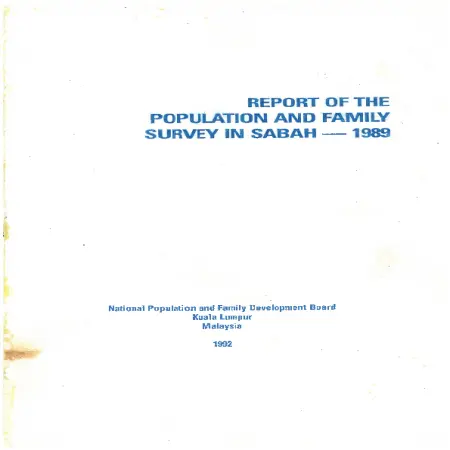Browse by Subject
Results for Search : "305 Social groups"
|
|
Profil keluarga/Family profile Malaysia
Item Type: Research Report
Editor:
Year: 00/00/1999
Abstract: The book on Family Profile: Findings of studies contains information from studies done by NPFDB namely Population and Family Survey,1984 and 1994, The socio-Economic effects of population Ageing in Malaysia,1986, Malaysian Family life Survey 1988, Sub-National District population Survey (Kajian Penduduk Daerah) 1992. A survey on the Effects of Socio-Economic Development on Family and Gender Relations in Kuala Lumpur,1995, Adolescents Social Behaviour in Malaysia 1994/95, Adolescents Social Behaviour 1993 and Terengganu, 1995 and Adolescents Reproductive Health and Sexual Behaviour in Malaysia, 1994/95.The findings of these studies have been analysed and arranged according to the changing patterns and trends that have occurred to families since 1986. Some of these studies are representative of Peninsular Malaysia while others are confined only to certain areas of the Peninsular. Nevertheless, the description of situations derived from these findings are consistent and reliable.
|
|
|
|
|
|
Profil penduduk/Population profile Malaysia
Item Type: Research Report
Editor:
Year: 00/00/1999
Abstract: This report aims at providing comprehensive information on population dynamics which covers fertility, mortality and migration. The information which has been gathered from the study findings of NPFDB, population censuses and vital statistics, is presented in a user friendly style for easy reference. It is envisaged that this information will provide useful input for public sector planning as well as the formulation of policies and implementation of programmes. The private sector, on the other hand will find it useful for the planning of businesses and industries.
|
|
|
|
|
|
Report of the Population and Family Survey in Sarawak - 1989
Item Type: Research Report
Editor:
Year: 00/00/1992
Abstract: The main objective of the Population and Family Survey in Sarawak was to provide necessary data for the formulation, implementation and evaluation of population and family development programmes, in line with national objectives. Specifically, the survey was conducted to collect information on socio-cultural determinants of fertility and maternity patterns, fertility preferences and behaviour, female labour force participation, childcare arrangement, family life, family planning practices, socio-economic status of subgroups, as well as population profiles and migratory patterns.
|
|
|
|
|
|
Report of The Population and Family Survey in Sabah - 1989
Item Type: Research Report
Editor:
Year: 00/00/1992
Abstract: The main objective of the survey was to provide necessary data for the formulation, implementation and evaluation of population and family development programmes, in line with national objectives. Specifically, the survey was conducted to collect information on socio-cultural determinants of fertility and maternity patterns, fertility preferences and behaviour, female labour force participation, childcare arrangement, family life, family planning practices, socio-economic status of subgroups, as well as population profiles and migration patterns.
|
|
|
|
|
|
Population Policy Malaysia towards a population of seventy million
Item Type: Act & Policy
Editor:
Year: 00/07/1984
Abstract: Based on this study the present population growth trend indicates that the population of Malaysia will stabilise at or around 39 million by the year 2150. In order to achieve an ultimate population size of 7O million, the present demographic trend has to be changed so that the rate of fertility decline is reduced by 0.1. point every 5 years. In this manner, the target would be achieved within approximately 115 years times, namely around the year 2100.
|
|
|
|
|
|
The report on West Malaysian Family Survey 1966-1967
Item Type: Research Report
Editor:
Year: 00/01/1968
Abstract: The data presented in this report was collected under the Statistics Act, No 34, 1965 by the Department of Statistics. This report is the First Malaysia-Wide Family survey was conducted at the end of 1966 and the beginning of 1967 with the objective of the finding Knowledge, Attitude and Practice of the people in Family Planning.
|
|
|
|










